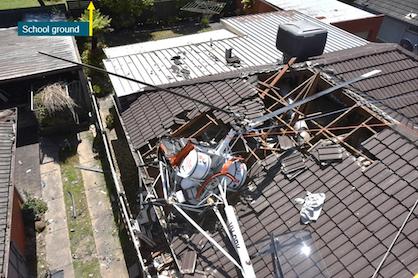Light Helicopter Rooftop Collision, Power Loss at Low Level (How far away is death?)

A light helicopter’s collision with rooftops in Melbourne’s south-east demonstrates the challenges pilots face managing engine power loss at low level, an Australian Transport Safety Bureau (ATSB) investigation report explains.
On the afternoon of November 30, 2022, a Hughes 269C three-seat light helicopter flying at a low level collided with the roofs of two houses near Moorabbin Airport, resulting in serious injuries to the solo student pilot, and substantial damage to the helicopter.
The pilot had been returning to Moorabbin after a second solo navigation training flight, when the approach became unstable, and he commenced a go-around.
“As the helicopter climbed to about 650 ft. above ground level, the engine lost power,” ATSB Director Transport Safety Stuart Macleod said.
“While the pilot identified a reduction in performance at this time, they did not immediately recognize the engine had lost power.”
The ATSB report notes that while the pilot was troubleshooting the reduction in engine performance, the light helicopter passed two suitable sites for a forced landing.
“When the pilot recognized a forced landing was required, he then did not identify a nearby football oval as the closest suitable area, possibly due to it being obscured by the airframe or instrument panel,” Mr. Macleod said.
“Instead, they identified a school ground, and attempted a landing there, but collided with rooftops short of this intended location as the helicopter had insufficient height.”
The accident highlights the challenges pilots face when confronted with a loss of engine power at low level, and with few suitable landing areas available.
“Pilots can best mitigate the effects of a power loss by forward planning, which reduces your mental workload under stress,” Mr. Macleod said.
The Civil Aviation Safety Authority has provided guidance on this topic, with its Guidelines for helicopters – suitable places to take off and land circular. This recommends that before take-off, pilots make themselves aware of suitable forced landing areas along their planned flight path, from the lift-off point to a safe maneuvering height.
“The engine power loss occurred at low height over a densely populated area presenting a challenging scenario for the inexperienced student pilot,” Mr. Macleod noted.
“While in this case, the selected landing location was unable to be reached, importantly, the pilot maintained control of the helicopter to maximize survivability.”
| Key points – Student pilot did not immediately identify an engine power loss, which limited the opportunities for a safe forced landing; – Helicopter impacted the roof of a house short of identified forced landing area, but pilot maintained control enough to maximise survivability; – Accident highlights importance of forward planning for possible forced landings shortly after take-off. |
Read the ATSB report: AO-2022-063: Collision with terrain involving Hughes Helicopters 269C, VH-OBK, near Moorabbin Airport, Victoria, on 30 November 2022
Content/photo source/credit: ATSB, “Helicopter’s collision with suburban rooftops after engine power loss highlights importance of forward planning,” publication date, 3/30/2023.
Become trained in TapRooT® troubleshooting and identifying root causes of issues and incidents.
REGISTER TODAY for a TapRooT® course and gain advantage, experience, and expertise from our professional instructors.



